Theories and Practices of Development
VerifiedAdded on 2023/01/23
|9
|2522
|41
AI Summary
This document discusses the differences between the Sustainable Development Goals (SDGs) and the Millennium Development Goals (MDGs), the challenges of sustainable development, and the impact of globalization on poverty reduction. It also explores the rights-based approach to development and the concept of post-development.
Contribute Materials
Your contribution can guide someone’s learning journey. Share your
documents today.
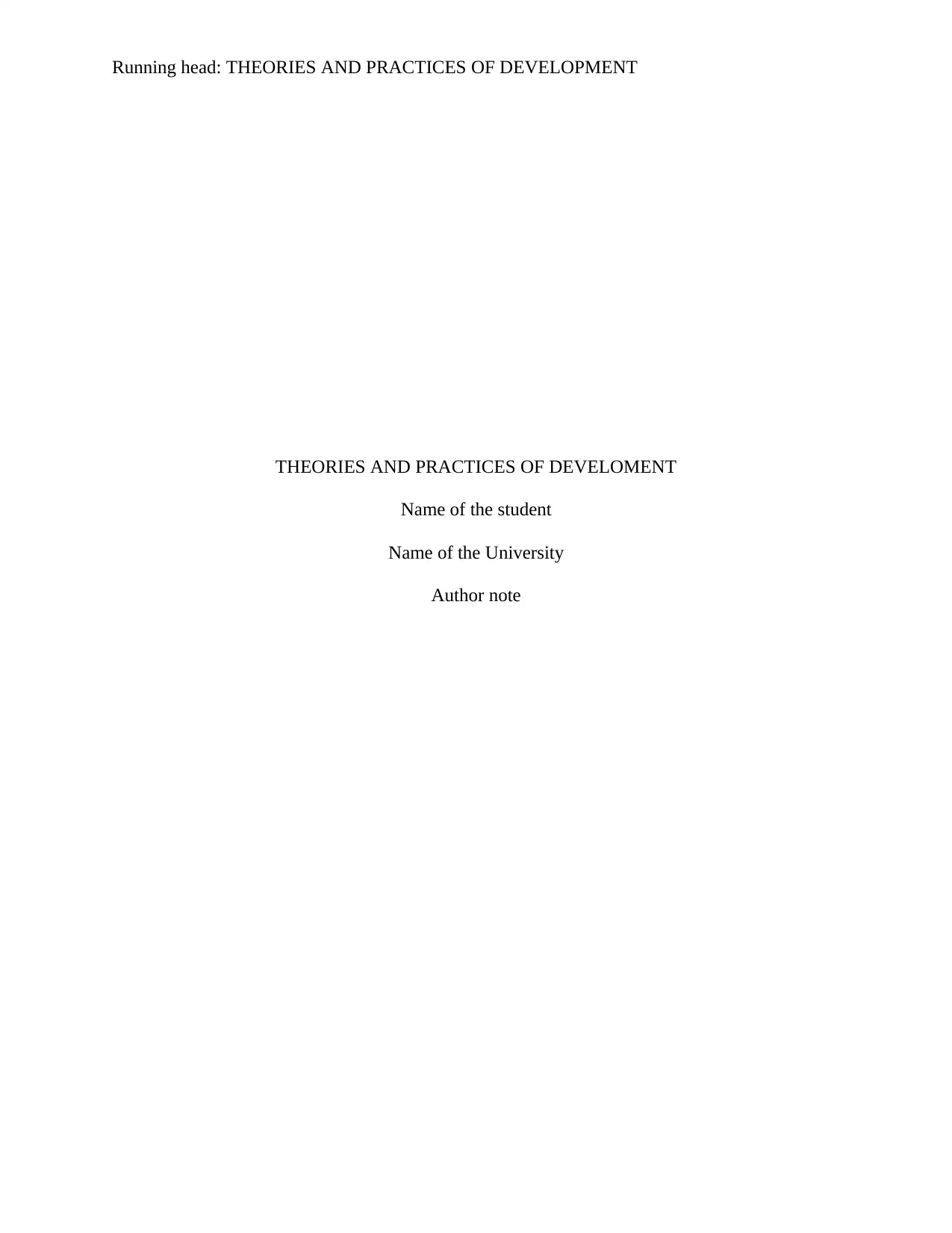
Running head: THEORIES AND PRACTICES OF DEVELOPMENT
THEORIES AND PRACTICES OF DEVELOMENT
Name of the student
Name of the University
Author note
THEORIES AND PRACTICES OF DEVELOMENT
Name of the student
Name of the University
Author note
Secure Best Marks with AI Grader
Need help grading? Try our AI Grader for instant feedback on your assignments.
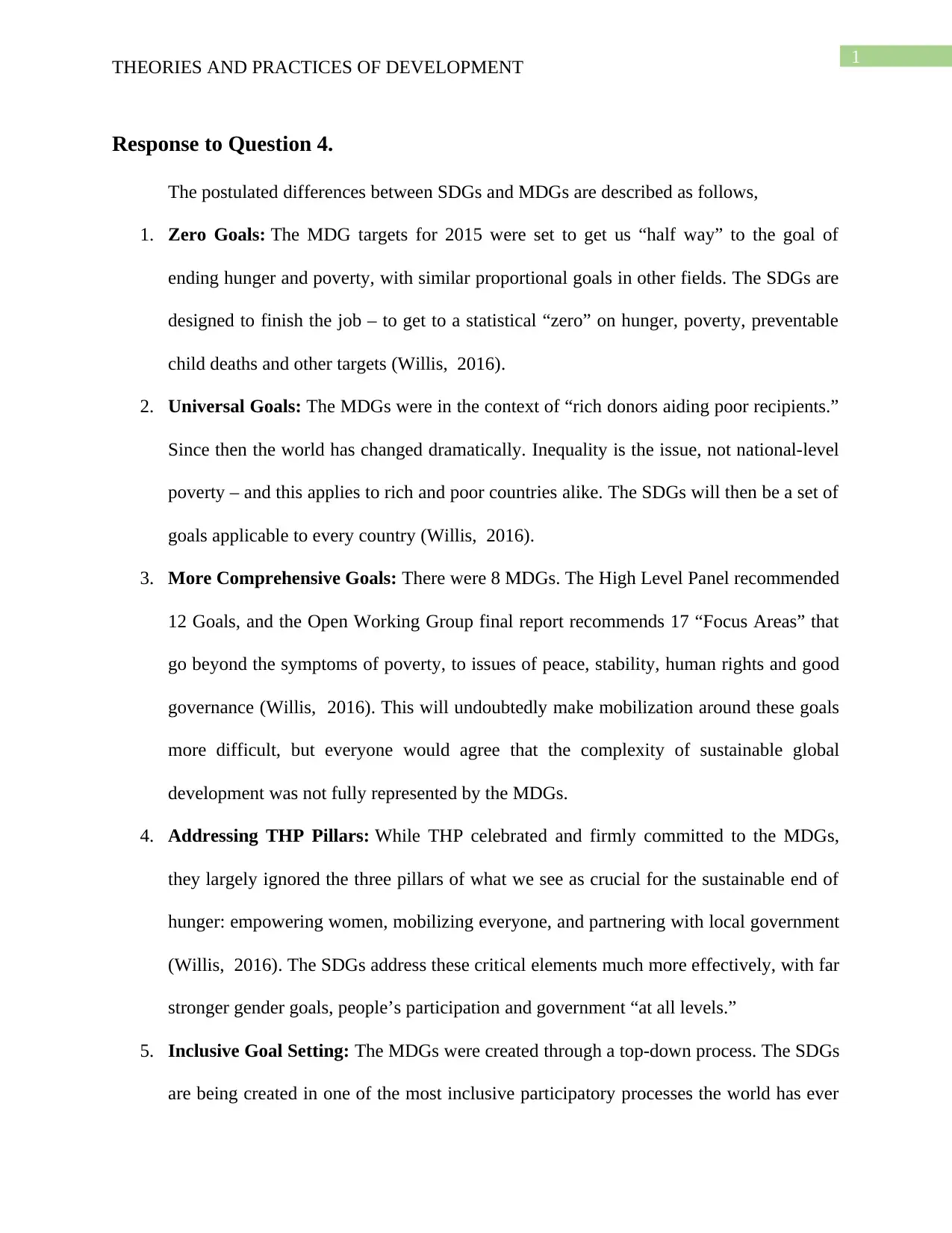
1
THEORIES AND PRACTICES OF DEVELOPMENT
Response to Question 4.
The postulated differences between SDGs and MDGs are described as follows,
1. Zero Goals: The MDG targets for 2015 were set to get us “half way” to the goal of
ending hunger and poverty, with similar proportional goals in other fields. The SDGs are
designed to finish the job – to get to a statistical “zero” on hunger, poverty, preventable
child deaths and other targets (Willis, 2016).
2. Universal Goals: The MDGs were in the context of “rich donors aiding poor recipients.”
Since then the world has changed dramatically. Inequality is the issue, not national-level
poverty – and this applies to rich and poor countries alike. The SDGs will then be a set of
goals applicable to every country (Willis, 2016).
3. More Comprehensive Goals: There were 8 MDGs. The High Level Panel recommended
12 Goals, and the Open Working Group final report recommends 17 “Focus Areas” that
go beyond the symptoms of poverty, to issues of peace, stability, human rights and good
governance (Willis, 2016). This will undoubtedly make mobilization around these goals
more difficult, but everyone would agree that the complexity of sustainable global
development was not fully represented by the MDGs.
4. Addressing THP Pillars: While THP celebrated and firmly committed to the MDGs,
they largely ignored the three pillars of what we see as crucial for the sustainable end of
hunger: empowering women, mobilizing everyone, and partnering with local government
(Willis, 2016). The SDGs address these critical elements much more effectively, with far
stronger gender goals, people’s participation and government “at all levels.”
5. Inclusive Goal Setting: The MDGs were created through a top-down process. The SDGs
are being created in one of the most inclusive participatory processes the world has ever
THEORIES AND PRACTICES OF DEVELOPMENT
Response to Question 4.
The postulated differences between SDGs and MDGs are described as follows,
1. Zero Goals: The MDG targets for 2015 were set to get us “half way” to the goal of
ending hunger and poverty, with similar proportional goals in other fields. The SDGs are
designed to finish the job – to get to a statistical “zero” on hunger, poverty, preventable
child deaths and other targets (Willis, 2016).
2. Universal Goals: The MDGs were in the context of “rich donors aiding poor recipients.”
Since then the world has changed dramatically. Inequality is the issue, not national-level
poverty – and this applies to rich and poor countries alike. The SDGs will then be a set of
goals applicable to every country (Willis, 2016).
3. More Comprehensive Goals: There were 8 MDGs. The High Level Panel recommended
12 Goals, and the Open Working Group final report recommends 17 “Focus Areas” that
go beyond the symptoms of poverty, to issues of peace, stability, human rights and good
governance (Willis, 2016). This will undoubtedly make mobilization around these goals
more difficult, but everyone would agree that the complexity of sustainable global
development was not fully represented by the MDGs.
4. Addressing THP Pillars: While THP celebrated and firmly committed to the MDGs,
they largely ignored the three pillars of what we see as crucial for the sustainable end of
hunger: empowering women, mobilizing everyone, and partnering with local government
(Willis, 2016). The SDGs address these critical elements much more effectively, with far
stronger gender goals, people’s participation and government “at all levels.”
5. Inclusive Goal Setting: The MDGs were created through a top-down process. The SDGs
are being created in one of the most inclusive participatory processes the world has ever
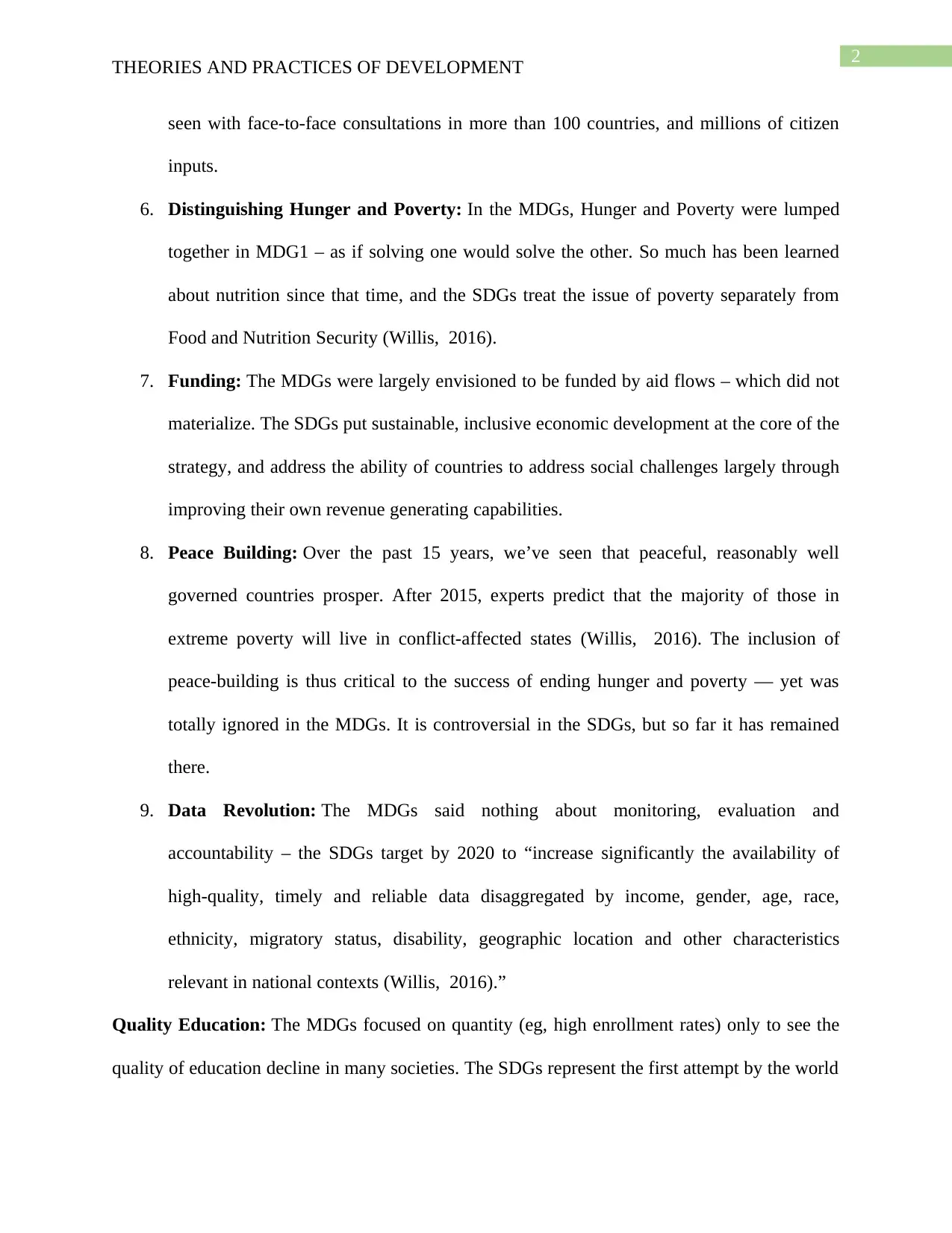
2
THEORIES AND PRACTICES OF DEVELOPMENT
seen with face-to-face consultations in more than 100 countries, and millions of citizen
inputs.
6. Distinguishing Hunger and Poverty: In the MDGs, Hunger and Poverty were lumped
together in MDG1 – as if solving one would solve the other. So much has been learned
about nutrition since that time, and the SDGs treat the issue of poverty separately from
Food and Nutrition Security (Willis, 2016).
7. Funding: The MDGs were largely envisioned to be funded by aid flows – which did not
materialize. The SDGs put sustainable, inclusive economic development at the core of the
strategy, and address the ability of countries to address social challenges largely through
improving their own revenue generating capabilities.
8. Peace Building: Over the past 15 years, we’ve seen that peaceful, reasonably well
governed countries prosper. After 2015, experts predict that the majority of those in
extreme poverty will live in conflict-affected states (Willis, 2016). The inclusion of
peace-building is thus critical to the success of ending hunger and poverty — yet was
totally ignored in the MDGs. It is controversial in the SDGs, but so far it has remained
there.
9. Data Revolution: The MDGs said nothing about monitoring, evaluation and
accountability – the SDGs target by 2020 to “increase significantly the availability of
high-quality, timely and reliable data disaggregated by income, gender, age, race,
ethnicity, migratory status, disability, geographic location and other characteristics
relevant in national contexts (Willis, 2016).”
Quality Education: The MDGs focused on quantity (eg, high enrollment rates) only to see the
quality of education decline in many societies. The SDGs represent the first attempt by the world
THEORIES AND PRACTICES OF DEVELOPMENT
seen with face-to-face consultations in more than 100 countries, and millions of citizen
inputs.
6. Distinguishing Hunger and Poverty: In the MDGs, Hunger and Poverty were lumped
together in MDG1 – as if solving one would solve the other. So much has been learned
about nutrition since that time, and the SDGs treat the issue of poverty separately from
Food and Nutrition Security (Willis, 2016).
7. Funding: The MDGs were largely envisioned to be funded by aid flows – which did not
materialize. The SDGs put sustainable, inclusive economic development at the core of the
strategy, and address the ability of countries to address social challenges largely through
improving their own revenue generating capabilities.
8. Peace Building: Over the past 15 years, we’ve seen that peaceful, reasonably well
governed countries prosper. After 2015, experts predict that the majority of those in
extreme poverty will live in conflict-affected states (Willis, 2016). The inclusion of
peace-building is thus critical to the success of ending hunger and poverty — yet was
totally ignored in the MDGs. It is controversial in the SDGs, but so far it has remained
there.
9. Data Revolution: The MDGs said nothing about monitoring, evaluation and
accountability – the SDGs target by 2020 to “increase significantly the availability of
high-quality, timely and reliable data disaggregated by income, gender, age, race,
ethnicity, migratory status, disability, geographic location and other characteristics
relevant in national contexts (Willis, 2016).”
Quality Education: The MDGs focused on quantity (eg, high enrollment rates) only to see the
quality of education decline in many societies. The SDGs represent the first attempt by the world

3
THEORIES AND PRACTICES OF DEVELOPMENT
community to focus on the quality of education – of learning – and the role of education in
achieving a more humane world: “education for sustainable development and sustainable
lifestyles, human rights, gender equality, promotion of a culture of peace and non-violence,
global citizenship, and appreciation of cultural diversity and of culture’s contribution to
sustainable development. Solar Energy: The greatest advantages of solar energy are that it is
completely free and is available in limitless supply. Both of these factors provide a huge benefit
to consumers and help reduce pollution. Replacing non-renewable energy with this type of
energy is both environmentally and financially effective (Willis, 2016).
Thoughts on the challenges
Lack of financial resources to carry out and plan sustainable development
Sustainable development is often not possible in war-torn countries as there are other priorities
on hand. The governmental conflict between immediate profit and investment towards
sustainable technologies. (In Poland, the government has even increased financing towards the
mining sector instead of moving full steam ahead towards adopting sustainable energy sources,
with coal amounting towards 80% of total energy generation in Poland (Willis, 2016).
Response to Question 6.
I personally do not believe that the Canadian government is doing enough to protect the
environment. Iam especially disappointed by the fact that Canada was unable to meet the target
of the Kyoto Protocol, and so withdrew before the 2012 deadline (Willis, 2016). The
Conservative government pulled Canada out of the agreement when it became clear that Canada
would not be able to meet the goal of reducing annual CO2 emissions to below 1990 levels. Peter
Kent, the Environment Minister at the time, said that Canada would have had to pay $14 billion
in penalties for not meeting the requirements, and thus withdrawing from the agreement was
THEORIES AND PRACTICES OF DEVELOPMENT
community to focus on the quality of education – of learning – and the role of education in
achieving a more humane world: “education for sustainable development and sustainable
lifestyles, human rights, gender equality, promotion of a culture of peace and non-violence,
global citizenship, and appreciation of cultural diversity and of culture’s contribution to
sustainable development. Solar Energy: The greatest advantages of solar energy are that it is
completely free and is available in limitless supply. Both of these factors provide a huge benefit
to consumers and help reduce pollution. Replacing non-renewable energy with this type of
energy is both environmentally and financially effective (Willis, 2016).
Thoughts on the challenges
Lack of financial resources to carry out and plan sustainable development
Sustainable development is often not possible in war-torn countries as there are other priorities
on hand. The governmental conflict between immediate profit and investment towards
sustainable technologies. (In Poland, the government has even increased financing towards the
mining sector instead of moving full steam ahead towards adopting sustainable energy sources,
with coal amounting towards 80% of total energy generation in Poland (Willis, 2016).
Response to Question 6.
I personally do not believe that the Canadian government is doing enough to protect the
environment. Iam especially disappointed by the fact that Canada was unable to meet the target
of the Kyoto Protocol, and so withdrew before the 2012 deadline (Willis, 2016). The
Conservative government pulled Canada out of the agreement when it became clear that Canada
would not be able to meet the goal of reducing annual CO2 emissions to below 1990 levels. Peter
Kent, the Environment Minister at the time, said that Canada would have had to pay $14 billion
in penalties for not meeting the requirements, and thus withdrawing from the agreement was
Secure Best Marks with AI Grader
Need help grading? Try our AI Grader for instant feedback on your assignments.

4
THEORIES AND PRACTICES OF DEVELOPMENT
more beneficial to Canadian taxpayers and to the economy. However, New Democrat
environment critic Megan Leslie argued that there were no penalties under Kyoto and that the
Conservatives pulled out of the agreement simply to prevent them having to report that Canada
did not meet the Kyoto targets. In any case, I find it disheartening that Canada was unable to
meet the targets and I feel that it demonstrates how much more of an emphasis Canada needs to
put on cutting back pollution.
Canada’s response in refugee crisis- Generally good (Willis, 2016). I appreciate the
comprehensive approach being taken, with money donated to the UNHCR to support refugees
hosted in countries near Syria, as well as the significant relocation program that has been created.
In my opinion, this represents a fair balance in terms of exercising Canada’s international
responsibility. It is also worth noting that the political climate for refugees is far more open in
Canada than south of the border, in part because prominent Canadian politicians and public
officials (e.g. the Prime Minister, the Commissioner of the RCMP, the Director of CSIS) have
issued careful statements supporting the processes Canada has adopted.
Response to Question 5.
Helps in reduction of poverty- Globalization is responsible for dramatically reducing the
number of abjectly poor people around the world, according to a new study that contradicts the
claims of skeptics who say it has worsened global poverty.
"On average economic growth is good for the poor, and trade is good for growth," said the study
by the London-based Centre for Economic Policy Research (Willis, 2016).
The study, prepared for the European Commission by a group of respected economists who
surveyed existing literature and studies on globalization, was unambiguous in saying that almost
every criticism levelled by free trade's skeptics is wrong.
THEORIES AND PRACTICES OF DEVELOPMENT
more beneficial to Canadian taxpayers and to the economy. However, New Democrat
environment critic Megan Leslie argued that there were no penalties under Kyoto and that the
Conservatives pulled out of the agreement simply to prevent them having to report that Canada
did not meet the Kyoto targets. In any case, I find it disheartening that Canada was unable to
meet the targets and I feel that it demonstrates how much more of an emphasis Canada needs to
put on cutting back pollution.
Canada’s response in refugee crisis- Generally good (Willis, 2016). I appreciate the
comprehensive approach being taken, with money donated to the UNHCR to support refugees
hosted in countries near Syria, as well as the significant relocation program that has been created.
In my opinion, this represents a fair balance in terms of exercising Canada’s international
responsibility. It is also worth noting that the political climate for refugees is far more open in
Canada than south of the border, in part because prominent Canadian politicians and public
officials (e.g. the Prime Minister, the Commissioner of the RCMP, the Director of CSIS) have
issued careful statements supporting the processes Canada has adopted.
Response to Question 5.
Helps in reduction of poverty- Globalization is responsible for dramatically reducing the
number of abjectly poor people around the world, according to a new study that contradicts the
claims of skeptics who say it has worsened global poverty.
"On average economic growth is good for the poor, and trade is good for growth," said the study
by the London-based Centre for Economic Policy Research (Willis, 2016).
The study, prepared for the European Commission by a group of respected economists who
surveyed existing literature and studies on globalization, was unambiguous in saying that almost
every criticism levelled by free trade's skeptics is wrong.
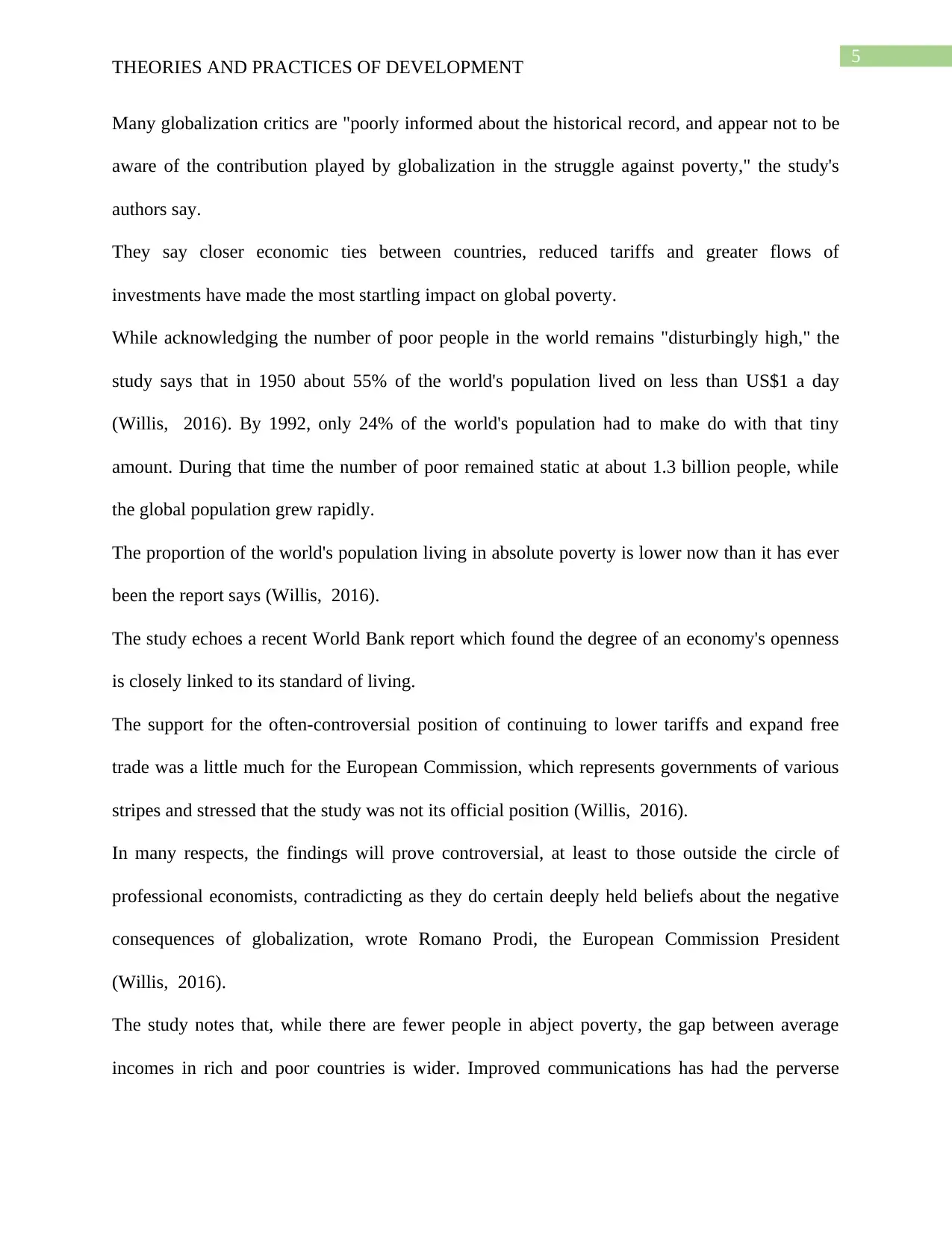
5
THEORIES AND PRACTICES OF DEVELOPMENT
Many globalization critics are "poorly informed about the historical record, and appear not to be
aware of the contribution played by globalization in the struggle against poverty," the study's
authors say.
They say closer economic ties between countries, reduced tariffs and greater flows of
investments have made the most startling impact on global poverty.
While acknowledging the number of poor people in the world remains "disturbingly high," the
study says that in 1950 about 55% of the world's population lived on less than US$1 a day
(Willis, 2016). By 1992, only 24% of the world's population had to make do with that tiny
amount. During that time the number of poor remained static at about 1.3 billion people, while
the global population grew rapidly.
The proportion of the world's population living in absolute poverty is lower now than it has ever
been the report says (Willis, 2016).
The study echoes a recent World Bank report which found the degree of an economy's openness
is closely linked to its standard of living.
The support for the often-controversial position of continuing to lower tariffs and expand free
trade was a little much for the European Commission, which represents governments of various
stripes and stressed that the study was not its official position (Willis, 2016).
In many respects, the findings will prove controversial, at least to those outside the circle of
professional economists, contradicting as they do certain deeply held beliefs about the negative
consequences of globalization, wrote Romano Prodi, the European Commission President
(Willis, 2016).
The study notes that, while there are fewer people in abject poverty, the gap between average
incomes in rich and poor countries is wider. Improved communications has had the perverse
THEORIES AND PRACTICES OF DEVELOPMENT
Many globalization critics are "poorly informed about the historical record, and appear not to be
aware of the contribution played by globalization in the struggle against poverty," the study's
authors say.
They say closer economic ties between countries, reduced tariffs and greater flows of
investments have made the most startling impact on global poverty.
While acknowledging the number of poor people in the world remains "disturbingly high," the
study says that in 1950 about 55% of the world's population lived on less than US$1 a day
(Willis, 2016). By 1992, only 24% of the world's population had to make do with that tiny
amount. During that time the number of poor remained static at about 1.3 billion people, while
the global population grew rapidly.
The proportion of the world's population living in absolute poverty is lower now than it has ever
been the report says (Willis, 2016).
The study echoes a recent World Bank report which found the degree of an economy's openness
is closely linked to its standard of living.
The support for the often-controversial position of continuing to lower tariffs and expand free
trade was a little much for the European Commission, which represents governments of various
stripes and stressed that the study was not its official position (Willis, 2016).
In many respects, the findings will prove controversial, at least to those outside the circle of
professional economists, contradicting as they do certain deeply held beliefs about the negative
consequences of globalization, wrote Romano Prodi, the European Commission President
(Willis, 2016).
The study notes that, while there are fewer people in abject poverty, the gap between average
incomes in rich and poor countries is wider. Improved communications has had the perverse
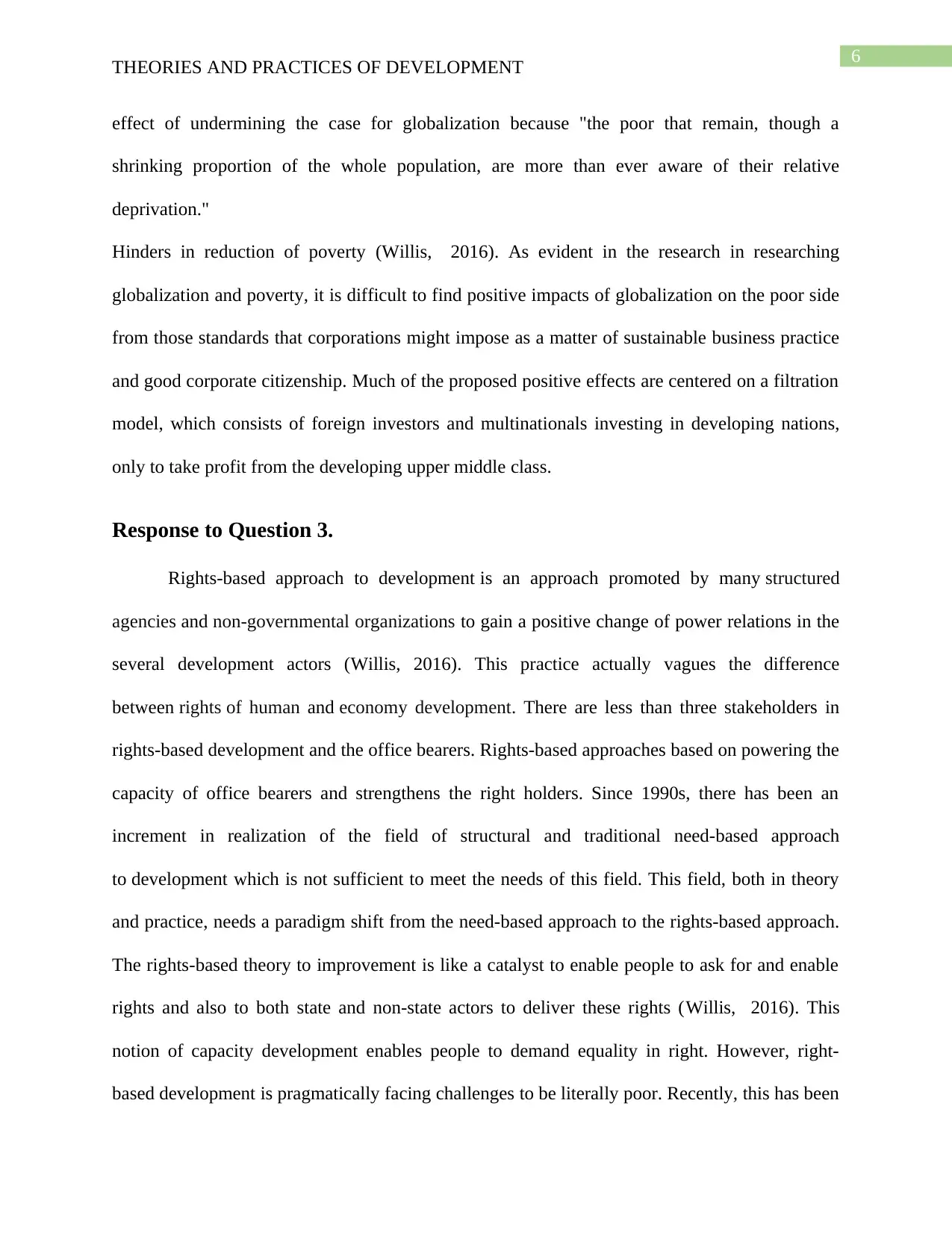
6
THEORIES AND PRACTICES OF DEVELOPMENT
effect of undermining the case for globalization because "the poor that remain, though a
shrinking proportion of the whole population, are more than ever aware of their relative
deprivation."
Hinders in reduction of poverty (Willis, 2016). As evident in the research in researching
globalization and poverty, it is difficult to find positive impacts of globalization on the poor side
from those standards that corporations might impose as a matter of sustainable business practice
and good corporate citizenship. Much of the proposed positive effects are centered on a filtration
model, which consists of foreign investors and multinationals investing in developing nations,
only to take profit from the developing upper middle class.
Response to Question 3.
Rights-based approach to development is an approach promoted by many structured
agencies and non-governmental organizations to gain a positive change of power relations in the
several development actors (Willis, 2016). This practice actually vagues the difference
between rights of human and economy development. There are less than three stakeholders in
rights-based development and the office bearers. Rights-based approaches based on powering the
capacity of office bearers and strengthens the right holders. Since 1990s, there has been an
increment in realization of the field of structural and traditional need-based approach
to development which is not sufficient to meet the needs of this field. This field, both in theory
and practice, needs a paradigm shift from the need-based approach to the rights-based approach.
The rights-based theory to improvement is like a catalyst to enable people to ask for and enable
rights and also to both state and non-state actors to deliver these rights (Willis, 2016). This
notion of capacity development enables people to demand equality in right. However, right-
based development is pragmatically facing challenges to be literally poor. Recently, this has been
THEORIES AND PRACTICES OF DEVELOPMENT
effect of undermining the case for globalization because "the poor that remain, though a
shrinking proportion of the whole population, are more than ever aware of their relative
deprivation."
Hinders in reduction of poverty (Willis, 2016). As evident in the research in researching
globalization and poverty, it is difficult to find positive impacts of globalization on the poor side
from those standards that corporations might impose as a matter of sustainable business practice
and good corporate citizenship. Much of the proposed positive effects are centered on a filtration
model, which consists of foreign investors and multinationals investing in developing nations,
only to take profit from the developing upper middle class.
Response to Question 3.
Rights-based approach to development is an approach promoted by many structured
agencies and non-governmental organizations to gain a positive change of power relations in the
several development actors (Willis, 2016). This practice actually vagues the difference
between rights of human and economy development. There are less than three stakeholders in
rights-based development and the office bearers. Rights-based approaches based on powering the
capacity of office bearers and strengthens the right holders. Since 1990s, there has been an
increment in realization of the field of structural and traditional need-based approach
to development which is not sufficient to meet the needs of this field. This field, both in theory
and practice, needs a paradigm shift from the need-based approach to the rights-based approach.
The rights-based theory to improvement is like a catalyst to enable people to ask for and enable
rights and also to both state and non-state actors to deliver these rights (Willis, 2016). This
notion of capacity development enables people to demand equality in right. However, right-
based development is pragmatically facing challenges to be literally poor. Recently, this has been
Paraphrase This Document
Need a fresh take? Get an instant paraphrase of this document with our AI Paraphraser
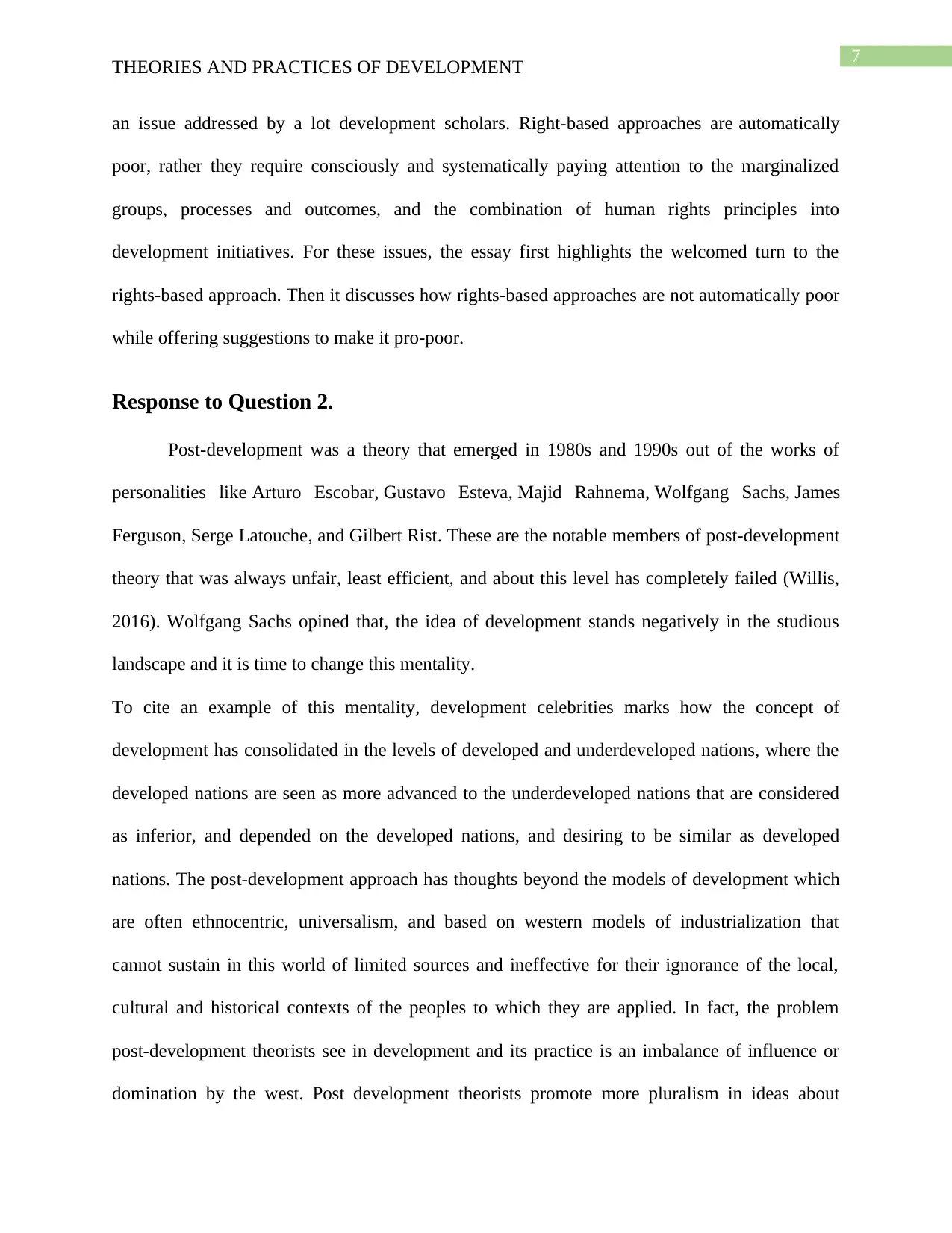
7
THEORIES AND PRACTICES OF DEVELOPMENT
an issue addressed by a lot development scholars. Right-based approaches are automatically
poor, rather they require consciously and systematically paying attention to the marginalized
groups, processes and outcomes, and the combination of human rights principles into
development initiatives. For these issues, the essay first highlights the welcomed turn to the
rights-based approach. Then it discusses how rights-based approaches are not automatically poor
while offering suggestions to make it pro-poor.
Response to Question 2.
Post-development was a theory that emerged in 1980s and 1990s out of the works of
personalities like Arturo Escobar, Gustavo Esteva, Majid Rahnema, Wolfgang Sachs, James
Ferguson, Serge Latouche, and Gilbert Rist. These are the notable members of post-development
theory that was always unfair, least efficient, and about this level has completely failed (Willis,
2016). Wolfgang Sachs opined that, the idea of development stands negatively in the studious
landscape and it is time to change this mentality.
To cite an example of this mentality, development celebrities marks how the concept of
development has consolidated in the levels of developed and underdeveloped nations, where the
developed nations are seen as more advanced to the underdeveloped nations that are considered
as inferior, and depended on the developed nations, and desiring to be similar as developed
nations. The post-development approach has thoughts beyond the models of development which
are often ethnocentric, universalism, and based on western models of industrialization that
cannot sustain in this world of limited sources and ineffective for their ignorance of the local,
cultural and historical contexts of the peoples to which they are applied. In fact, the problem
post-development theorists see in development and its practice is an imbalance of influence or
domination by the west. Post development theorists promote more pluralism in ideas about
THEORIES AND PRACTICES OF DEVELOPMENT
an issue addressed by a lot development scholars. Right-based approaches are automatically
poor, rather they require consciously and systematically paying attention to the marginalized
groups, processes and outcomes, and the combination of human rights principles into
development initiatives. For these issues, the essay first highlights the welcomed turn to the
rights-based approach. Then it discusses how rights-based approaches are not automatically poor
while offering suggestions to make it pro-poor.
Response to Question 2.
Post-development was a theory that emerged in 1980s and 1990s out of the works of
personalities like Arturo Escobar, Gustavo Esteva, Majid Rahnema, Wolfgang Sachs, James
Ferguson, Serge Latouche, and Gilbert Rist. These are the notable members of post-development
theory that was always unfair, least efficient, and about this level has completely failed (Willis,
2016). Wolfgang Sachs opined that, the idea of development stands negatively in the studious
landscape and it is time to change this mentality.
To cite an example of this mentality, development celebrities marks how the concept of
development has consolidated in the levels of developed and underdeveloped nations, where the
developed nations are seen as more advanced to the underdeveloped nations that are considered
as inferior, and depended on the developed nations, and desiring to be similar as developed
nations. The post-development approach has thoughts beyond the models of development which
are often ethnocentric, universalism, and based on western models of industrialization that
cannot sustain in this world of limited sources and ineffective for their ignorance of the local,
cultural and historical contexts of the peoples to which they are applied. In fact, the problem
post-development theorists see in development and its practice is an imbalance of influence or
domination by the west. Post development theorists promote more pluralism in ideas about

8
THEORIES AND PRACTICES OF DEVELOPMENT
development. The personality of Bono Vox, born as Paul David Hewson, belongs to the most
often discussed examples of the “celebritization” of development and serves to illustrate how a
media star can become an influential player in the field of setting the development agenda.
Leading experts in the field of celebrity development consider the year 1953 to be a landmark
regarding the engagement of publicly known personalities in development, when famous
American actor Danny Kaye was asked by the UN to become the first Goodwill Ambassador,
which earned him the nickname Mr. UNICEF
Reference
Willis, K. (2016). International development planning and the Sustainable Development Goals
(SDGs).
THEORIES AND PRACTICES OF DEVELOPMENT
development. The personality of Bono Vox, born as Paul David Hewson, belongs to the most
often discussed examples of the “celebritization” of development and serves to illustrate how a
media star can become an influential player in the field of setting the development agenda.
Leading experts in the field of celebrity development consider the year 1953 to be a landmark
regarding the engagement of publicly known personalities in development, when famous
American actor Danny Kaye was asked by the UN to become the first Goodwill Ambassador,
which earned him the nickname Mr. UNICEF
Reference
Willis, K. (2016). International development planning and the Sustainable Development Goals
(SDGs).
1 out of 9
Related Documents
Your All-in-One AI-Powered Toolkit for Academic Success.
+13062052269
info@desklib.com
Available 24*7 on WhatsApp / Email
![[object Object]](/_next/static/media/star-bottom.7253800d.svg)
Unlock your academic potential
© 2024 | Zucol Services PVT LTD | All rights reserved.





